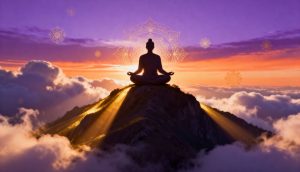In many images and statues of Buddha, his hands are not placed randomly. Each gesture, each posture, has a deep meaning that connects with ancient spiritual teachings.
These positions are called mudras and they express qualities such as peace, protection or wisdom. Observing them can inspire your inner journey.
The meaning of Buddhas according to their body postures
Buddha statues not only convey calm: each body position represents a key moment in his life or a spiritual teaching. Whether seated, standing or reclining, each image holds a message that can help us to better understand our own inner path.
Seated Buddha: meditation, balance, and inner awakening
The most common image is that of Buddha seated with crossed legs, in the lotus or half-lotus position. This position symbolizes deep meditation and the search for enlightenment. It is an invitation to inner silence, emotional balance, and to clearly observe what is happening within you.
In many statues, this Buddha appears with his hands in his lap (in the so-called Dhyana Mudra), reinforcing the message of contemplation. He may also be touching the earth with one hand, a gesture that represents the exact moment he achieved enlightenment under the Bodhi tree.
Standing Buddha: Compassionate Action and Steadfast Presence
Seeing the Standing Buddha speaks to us of conscious action. He represents a Buddha in motion, teaching, guiding, or protecting. This posture expresses the willingness to bring wisdom into the world, not just to remain in contemplation, but also to act from love and compassion.
Many times he is depicted with one or both hands raised, in a gesture of protection or teaching. His firm presence, without tension, reminds us that one can be active without losing one’s inner center.
Reclining Buddha: serenity in the face of change and liberation
The reclining Buddha, with his head resting on one hand, represents the moment of his entry into nirvana. But there is no pain or sadness: his serene expression speaks to us of acceptance, of liberation from suffering and of the closing of a life cycle with full awareness.
This image is powerful because it reminds us that everything is impermanent. It is not about death in the common sense, but about transcendence: letting go of what no longer serves to move towards a state of deep peace.

The language of hands: what does each mudra mean in Buddha statues?
The different gestures of Buddha’s hands, known as mudras, are not simple ornaments. Each one transmits a specific spiritual energy and represents key moments of his path towards enlightenment. Observing them can inspire us to cultivate qualities such as confidence, calm or compassion.
Hands up: protection, courage, and fearlessness
This gesture is called Abhaya Mudra and is usually done with the open palm facing forward, at chest or shoulder height. It represents divine protection, the ability to face life without fear and with an attitude of serene courage.
When we see this mudra in a Buddha statue, we can remind ourselves that it is possible to move forward in life with inner confidence, even in uncertain times. It is one of the most powerful gestures for those seeking emotional stability.
A hand touching the earth: connection, truth, and awakening
This gesture is called Bhumisparsha Mudra, and appears when Buddha is sitting with one of his hands touching the ground. It represents the exact moment he achieved enlightenment, calling the earth as a witness to his awakening.
It symbolizes the connection with reality, the commitment to truth, and the act of anchoring oneself to the present. It is a reminder that every spiritual process also needs firm roots and full presence.

Hands in the lap: meditation and inner balance
In this gesture, both hands rest on the lap, usually with palms facing up, and sometimes one hand over the other. It is the Dhyana Mudra, a symbol of deep meditation and the cultivation of the inner core.
This mudra invites contemplation, to observe without judgment, and to let the mind find its natural silence. It is common in Buddha figures that represent the process of inner transformation.
Palms together at the chest: respect, gratitude and sacred connection
This gesture, similar to what we use when saying “Namaste”, is known as Namaskara Mudra. It is an expression of reverence, of union between the human and the divine. It also symbolizes the spiritual communion between beings.
By using it, one recognizes the inner light in oneself and in others. It is a reminder that we are all connected by something deeper than forms.
A Hand in Blessing: Compassion and Spiritual Guidance
This gesture, sometimes with the hand down and fingers extended, represents the generous giving of energy or wisdom. It is the gesture of the teacher who guides without imposing, and of the being who gives without expecting anything in return.
This mudra invites us to cultivate active compassion, that force that heals without words and that is born from the deep understanding of the other.
The symbolism of Buddha in the home: how to choose a figure according to its message
Including a Buddha figure at home can be a subtle way to remind you of the connection with the spiritual. It is not just about decoration, but about creating a space that reflects your personal intentions and inspires you to live with more presence and calm.
Before choosing a statue, you can ask yourself: What energy do I want to invite into this space? Am I looking to center myself, let go, protect myself, or open my heart? The image of Buddha can help you reinforce that intention, becoming a living symbol of your inner practice.
You don’t need to understand all the gestures or follow strict rules. Sometimes, simply observing a figure that conveys peace or strength to you is enough. Over time, that object can become an anchor: a silent reminder of what you want to cultivate in your daily life.
You can place it in a quiet corner, on an altar, or even in a common area. The important thing is that you connect with its symbolic presence, and that it helps you return, again and again, to what really matters.

What does this have to do with the practice of yoga?
Although Buddha figures originate from Buddhism, their symbolism resonates deeply with many yoga teachings. Both traditions share values such as mindfulness, compassion, detachment, and inner search.
The mudras that we see in statues are also practiced in yoga as energetic gestures that help to focus the mind and direct intention. Many of them, such as the meditation gesture or the protection gesture, are also used during meditation and pranayama.
Furthermore, the postures of Buddha—serene, centered, in silence, or in conscious action—are visual reflections of the state many often seek to achieve through the practice of yoga: balance between body, mind, and spirit.
Having an image of Buddha nearby can be a gentle reminder that the path of yoga is not just physical. It is also a process of inner transformation, where presence, stillness, and compassionate gaze play a central role.







